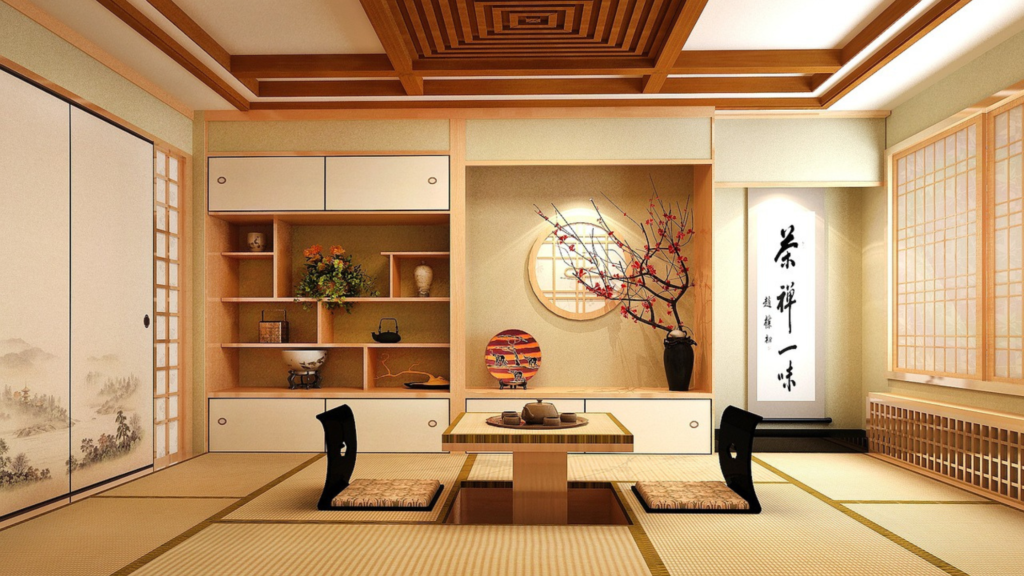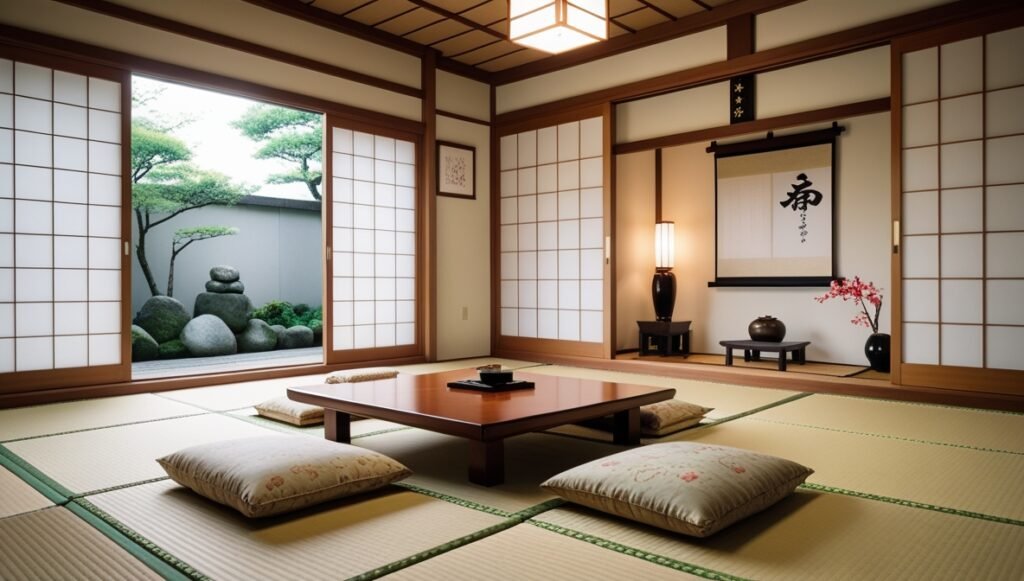When you step into a traditional Japanese home, you might notice something missing – chairs. Instead, many Japanese families sit directly on the floor, often on cushions called zabuton. The absence of chairs in traditional Japanese homes stems from practical space considerations and cultural traditions centered around tatami mats, which would be damaged by chair legs. This floor-sitting culture has shaped Japanese architecture, furniture design, and daily life for centuries.
Table of Contents
ToggleTatami rooms remain an essential element of traditional Japanese interior design. These straw mats create a unique living space where people eat, sleep, and socialize without the need for Western-style furniture. The small size of Japanese houses made this no-chair approach a wise solution for making the most of limited space, allowing rooms to serve multiple purposes throughout the day.
Traditional Japanese restaurants still embrace this cultural element, offering tatami rooms where diners sit on cushions at low tables. This arrangement creates a peaceful dining atmosphere that connects modern Japanese people with their cultural heritage. Though Western-style chairs have become common in contemporary Japanese homes, many families still maintain at least one tatami room as a link to traditional practices.
Historical Origins of Tatami in Japanese Homes
Tatami mats have deep roots in Japanese history, evolving from elite luxury items to essential elements in traditional home design. Their development shaped both Japanese interior spaces and cultural practices around home living.
The Evolution of Tatami Mats
Tatami mats first appeared during Japan’s Nara period in the 8th century as exclusive items for nobility. The word “tatami” appears in Japan’s oldest historical records. Initially, these mats were small, portable floor coverings used only by high-ranking officials and aristocrats.
By the Heian period (794-1185), tatami became more widespread among the upper classes. They weren’t yet used to cover entire floors but served as seating areas for important guests.
During the Muromachi period (1336-1573), tatami usage expanded dramatically. The mats grew larger and began covering entire room floors in elite homes. This period marked the transition from tatami as furniture to tatami as flooring.
By the Edo period (1603-1868), tatami had become common in Japanese homes across social classes. What was once a luxury reserved for nobility had transformed into a standard feature of Japanese residential architecture.
Tatami and Japanese Architecture
Tatami mats profoundly influenced Japanese architectural design. Traditional homes were built with standardized room dimensions based on tatami mat sizes. These rooms became known as washitsu.
A typical tatami mat measures approximately 90 by 180 centimeters, though sizes vary slightly by region. Room sizes were described by the number of tatami mats they could hold, such as a “six-mat room” or “eight-mat room.”
The integration of tatami created versatile living spaces that could serve multiple functions throughout the day. Without bulky furniture, rooms easily transformed from sleeping areas to dining spaces to gathering places.
This floor-based living system developed partly due to practical considerations. Japanese homes were traditionally small, and the no-chair culture allowed for efficient use of limited space. Tatami provided comfortable flooring for sitting, sleeping, and daily activities.
Cultural Significance of Tatami Rooms
Tatami rooms hold deep cultural meaning in Japanese society, influencing both daily interactions and spiritual practices. These traditional spaces connect modern Japanese people to centuries-old customs that continue to shape behavior and values.
Tatami in Social Etiquette
In Japanese homes with tatami rooms, specific etiquette rules apply that don’t exist in Western-style spaces. Visitors must remove shoes before stepping onto tatami, showing respect for the home and its cleanliness.
The arrangement of seating follows strict hierarchical rules. The highest-ranking guest sits farthest from the entrance (kamiza position), while the host takes the seat nearest the door (shimoza). This spatial organization reflects Japan’s attention to social status.
During tea ceremonies, participants move across tatami in prescribed patterns. They must fold their legs properly when sitting and avoid stepping on the decorative edges of mats.
Even modern Japanese who rarely use tatami understand these customs, as they remain important cultural knowledge passed through generations.
Religious and Symbolic Meanings
Tatami holds significant spiritual symbolism in Japanese culture. The traditional measurement of rooms by tatami count connects to Shinto and Buddhist practices, where specific numbers carry spiritual meaning.
The fresh scent of new tatami represents purification, while the natural materials honor the connection between humans and nature that sits at the core of Shinto beliefs.
In Buddhist temples, tatami creates spaces for meditation and prayer. The simplicity of tatami rooms aligns with Zen principles of minimalism and mindfulness.
The rectangular shape of tatami mats symbolizes balance and harmony. Even in modern times when 70% of Japanese homes still use tatami, these spaces serve as a reminder of traditional values in an increasingly Westernized society.
The Practical Aspects of Tatami-Floor Living
Tatami living offers both functional benefits and requires specific care routines. The traditional floor-sitting lifestyle shapes how Japanese homes are used and maintained in daily life.
Health and Comfort Benefits
Sitting and sleeping on tatami mats provides several physical advantages. The natural cushioning of tatami mats made from rice straw offers joint support while encouraging better posture. Many people report improved flexibility and core strength from regularly sitting on the floor.
The temperature-regulating properties of tatami are significant for comfort. These mats remain cool in summer and retain warmth in winter, creating a naturally comfortable living environment without excessive heating or cooling.
Floor sitting also promotes family togetherness. When everyone sits at the same level on large cushions called zaisu, the arrangement creates a sense of equality and intimacy during meals and gatherings.
Maintenance and Care
Tatami requires regular and specific maintenance to preserve its quality. Daily care includes using soft brooms for sweeping and prompt cleaning of spills to prevent staining or mold growth.
Proper ventilation is essential as tatami absorbs moisture easily. Residents should air out rooms regularly and avoid placing furniture directly on mats to prevent damage and allow proper air circulation.
Tatami mats should be rotated periodically to ensure even wear, typically every six months. Professional deep cleaning is recommended annually to remove embedded dirt and extend the life of the mats.
Sunlight exposure should be limited as it can cause tatami to fade or become damaged. Using designated tatami room slippers rather than outdoor footwear helps maintain cleanliness and prevent unnecessary wear.
Modern Adaptations and International Influence

Image by chxfly9527 from Pixabay
Traditional tatami culture has evolved significantly in recent decades, adapting to contemporary lifestyles while also gaining appreciation beyond Japan’s borders.
Tatami in Contemporary Japanese Homes
Modern Japanese families often blend traditional tatami elements with Western-style furniture. Today, about 70% of Japanese homes still incorporate tatami mats in some form, though rarely throughout the entire house.
Many apartments and houses feature a single tatami room called a “washitsu,” used for special occasions or guest accommodation. This practical approach allows families to maintain cultural traditions while enjoying modern conveniences.
Manufacturers now produce modern tatami variations with improved durability and stain resistance. Some designs feature half-height mats or modular sections that fit easily into contemporary spaces.
The multipurpose nature of tatami rooms remains valuable in urban areas where space is limited. These flexible spaces transform from living rooms to dining areas to bedrooms as needed.
Tatami’s Influence on Global Design
International interior designers have embraced tatami-inspired elements for their minimalist aesthetic and natural materials. Western homes increasingly feature low-profile furniture, natural rush flooring, and sliding partitions reminiscent of traditional Japanese interiors.
The space-saving wisdom of tatami culture particularly appeals to those living in compact urban apartments. Furniture retailers now offer modern interpretations of zaisu (legless chairs) and low tables suitable for international markets.
Wellness trends have further popularized tatami elements, as people seek calming, natural environments. The simplicity and connection to nature embedded in tatami room design aligns perfectly with contemporary desires for mindful living spaces.
European and American designers often incorporate tatami-inspired platforms or dedicated floor-seating areas in modern homes, creating versatile spaces for relaxation, meditation, or casual entertaining.
You might love these too
You might love these too
Let’s Stay Connected!
Our newsletter brings you peaceful places, meaningful traditions, and unseen beauty.
Our newsletter brings you peaceful places, meaningful traditions, and unseen beauty.
